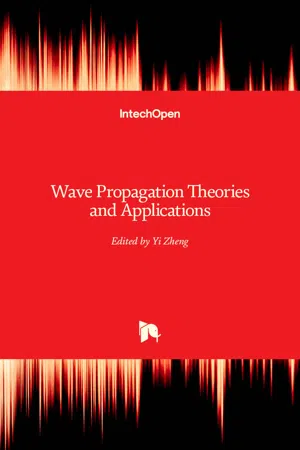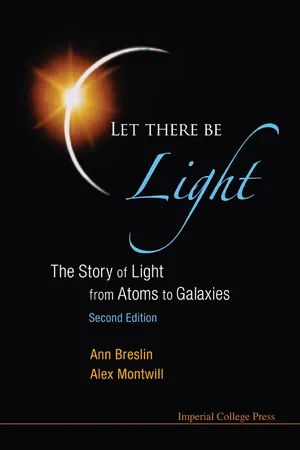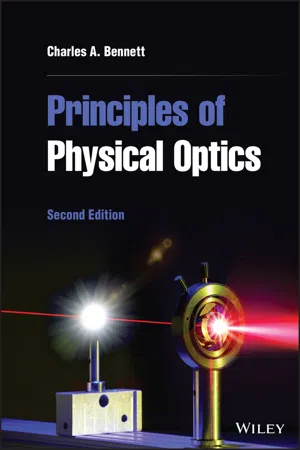Physics
Applications of Waves
Applications of waves in physics include communication technologies such as radio, television, and cell phones, which rely on the transmission of electromagnetic waves. Additionally, medical imaging techniques like ultrasound and MRI utilize the properties of waves to create detailed images of the human body. Industrial applications also use waves for non-destructive testing and materials processing.
Written by Perlego with AI-assistance
Related key terms
1 of 5
5 Key excerpts on "Applications of Waves"
- eBook - PDF
Wave Propagation
Theories and Applications
- Yi Zheng(Author)
- 2013(Publication Date)
- IntechOpen(Publisher)
Chapter 4 © 2013 Malik, licensee InTech. This is an open access chapter distributed under the terms of the Creative Commons Attribution License (http://creativecommons.org/licenses/by/3.0), which permits unrestricted use, distribution, and reproduction in any medium, provided the original work is properly cited. Electromagnetic Waves and Their Application to Charged Particle Acceleration Hitendra K. Malik Additional information is available at the end of the chapter http://dx.doi.org/10.5772/52246 1. Introduction A wave is a disturbance that propagates through space and time, usually with the transference of energy from one point to another without permanent displacement of particles of the medium. The particles under this situation only oscillate about their equilibrium positions. If the particles oscillate in the direction of wave propagation, then the wave is called longitudinal wave. However, if these oscillations take place in perpendicular direction with the direction of wave propagation, the wave is said to be transverse in nature. Electromagnetic (EM) waves are transverse in nature. In electromagnetic waves such as light waves, it is the changes in electric field and magnetic field that represent the wave disturbance. The propagation of the wave is described by the passage of a waveform through the medium with a certain velocity called the phase (or wave) velocity. However, the energy is transferred at the group velocity of the waves making the waveform. Electromagnetic radiation is a form of energy exhibiting wave like behavior as it travels through the space. The electromagnetic radiation is classified based on the frequency of its wave. Figure 1 shows the electromagnetic spectrum that consists of radio waves, microwaves, infrared (IR) radiation, visible light, ultraviolet (UV) radiation, X-rays and gamma rays. T-rays shown in the spectrum represent the terahertz (THz) radiations. - eBook - PDF
- James Shipman, Jerry Wilson, Charles Higgins, Bo Lou, James Shipman(Authors)
- 2020(Publication Date)
- Cengage Learning EMEA(Publisher)
141 CHAPTER 6 Waves and Sound You can’t just cut out the perfect wave and take it home with you. It’s constantly moving all the time. ● Jimi Hendrix (1942–1970) T he word wave brings to mind different things for different people. Prob- ably most would associate it with ocean waves (a big one is shown in the opening photo) or their smaller relatives, those on the surface of a lake or pond. Others might think of sound waves or light waves. Music is made up of sound waves, and we see beautiful rainbows because of light waves. Indeed, waves are all around us, and understanding their properties is essen- tial to describing our physical environment. Our eyes and ears are the two main wave-detecting devices that link us to our world. This and the next chapter explore the important roles that waves play in our lives. 6.1 Waves and Energy Propagation Key Questions ● ● What causes waves, and how and what do they propagate? ● ● Is matter propagated by waves? < Ride the wave! A surfer rides … the wave of a breaking surf. Richard Lyons/Shutterstock.com Did You Know? Section The visible region of the electromagnetic (EM) spectrum is very small and lies between the nonvisible infrared and ultraviolet regions. 6.3 Ultrasound (f . 20 kHz) cannot be heard by the human ear, but dogs, bats, and some insects can. 6.4 The bow wave of an aircraft flying faster than the speed of sound (supersonic) gives rise to a sonic boom. The crack of a whip is a “mini” sonic boom. 6.5 Chapter Outline 6.1 Waves and Energy Propagation 141 6.2 Wave Properties 143 6.3 Light Waves 146 6.4 Sound Waves 148 Conceptual Q&A 6.1 A Tree Fell 152 Highlight 6.1 Noise Exposure Limits 152 Physical Science Today 6.1 Deaf and Can Still Hear? Bone Conduction 153 6.5 The Doppler Effect 156 Conceptual Q&A 6.2 Faster Than Sound 157 6.6 Standing Waves and Resonance 158 Conceptual Q&A 6.3 It Can Be Shattering 160 Copyright 2021 Cengage Learning. - eBook - PDF
Let There Be Light: The Story Of Light From Atoms To Galaxies (2nd Edition)
The Story of Light from Atoms to Galaxies
- Alex Montwill, Ann Breslin(Authors)
- 2013(Publication Date)
- ICP(Publisher)
Even the sensation of touch relies on the transmission of nerve impulses, which are composed of wave packets. Electromagnetic waves, which pervade all space, and with-out which the universe could not exist, are the basic theme of this book. Light is just one member of that family. These waves propagate in a mysterious way, as we shall see in later chapters. We have learned to produce electromagnetic waves and to put them to a variety of uses, many of which are now taken almost for granted. Radio waves facilitate the remote communi-cation that enables us to hear and to see the latest news and to watch our favourite television programmes. We can receive information about the lunar surface from space probes. In med-icine, lasers produce waves for keyhole surgery; X-rays are used in diagnostic imaging and radiation therapy; infrared waves heat muscles and relieve pain. Microwaves cook food; radar waves guide planes and ships. Last but not least, a tiny infrared beam from our remote control allows us to change channels without leaving our armchair in front of the TV set! Waves on a sandy beach at Cabo Polonio, Uruguay. Courtesy of Johntex, 2006 . Introducing Waves 151 Once we become aware of the seemingly endless variety of waves, it begs questions such as: Do all waves have something in common? How can we deal with waves mathematically? What is the justification to say that light behaves as a wave? Mechanical waves in a medium When a medium is disturbed by a wave, individual particles oscillate about their equilibrium positions and transmit energy by their mutual interactions. A stone dropped into the middle of a pond gives rise to waves spreading out on the surface of the water in ever-increasing circles. The expanding waves show that something definitely propagates, but it is not the water itself; ducks sitting in the path of the wave bob up and down but do not necessarily move in the apparent direction of propagation. - eBook - PDF
- Charles A. Bennett(Author)
- 2022(Publication Date)
- Wiley(Publisher)
1 1 The Physics of Waves The solution of the difficulty is that the two mental pictures which experiment lead us to form — the one of the particles, the other of the waves — are both incomplete and have only the validity of analogies which are accurate only in limiting cases. Heisenberg 1.1 Introduction The properties of waves are central to the study of optics. As we will see, light (or more prop- erly, electromagnetic radiation) has both particle and wave properties. These complementary aspects are a result of quantum mechanics, and prior to the early 1900s, there were two schools of thought. Newton postulated that light consists of particles, while contemporaries Huygens and Hooke promoted a wave theory of light. The matter seemed settled with Young’s important double-slit experiment offering clear experimental evidence that light is a wave. Maxwell’s sweeping theory of electromagnetism finally provided a deep and complete description of electromagnetic waves that we consider in detail in Chapter 2. Although current theories of optics include both wave and particle descriptions, the wave picture still forms the bedrock of most optical technology. In this chapter, we will outline some general properties that apply to traveling waves of all types. 1.2 One-Dimensional Wave Equation Mechanical waves travel within elastic media whose material properties provide restoring forces that result in oscillation. When a guitar string is plucked, it is displaced away from its equilibrium position, and the mechanical energy of this disturbance subsequently propagates along the string as traveling waves. In this case, the waves are transverse, meaning that the displacement of the medium (the string) is perpendicular to the direction of energy travel. Acoustic waves in a gas are longitudinal, meaning that the gas molecules are displaced back and forth along the direction of energy flow as regions of high and low pressure are created along the wave. - eBook - PDF
Physical Optics
Principles and Practices
- Abdul Al-Azzawi(Author)
- 2018(Publication Date)
- CRC Press(Publisher)
1 Waves 1.1 INTRODUCTION Light acts as a stream of particles that allow the light to transfer from one point to another. The coming chapters will deal with light as a wave. The purpose of this chapter is to explain the basic principles of light when transmitted, reflected, or refracted through an optical material as a wave. Energy can be transmitted from one place to another by vibrating objects, such as water waves that travel hundreds of kilometres over the ocean. The water particles move up and down as the wave passes. Similarly, when you shake a spiral spring, your energy is transferred from coil to coil down the spring. A wave is a transfer of energy in the form of vibrating particles in a medium. We live in a world surrounded by waves; some are visible and others are not. Water waves and the waves generated by a rope or a spring can be seen. Sound waves and radio waves cannot be seen. Waves also occur in light, sound, heat, microwaves, and in the ultra-microscopic world of atoms. Several types of waves and their applications will be presented in this chapter. Also in this chapter, along with the theoretical presentation, three experimental cases demonstrate the principles of Hook’s law, wave generation, and the simple pendulum. 1.2 THE NATURE OF WAVES 1.2.1 E NERGY T RANSFER There are various ways in which energy can be transferred from one place to another. The flow of heat through a metal from a region of high temperature to one of low temperature represents one method of transferring energy. The flow of electricity through a metal is somewhat analogous to heat flow. The conduction of heat energy and electric energy through metals depends upon the motion of particles that compose the metal. 1 The transfer of energy by the gross movement of materials or objects from one place to another is the basic principle of the nature of waves. Winds, tides, and projectiles in flight are examples for this type.
Index pages curate the most relevant extracts from our library of academic textbooks. They’ve been created using an in-house natural language model (NLM), each adding context and meaning to key research topics.




